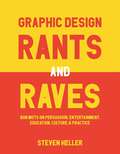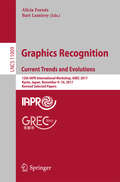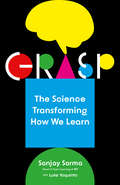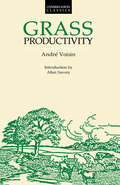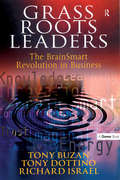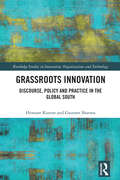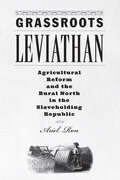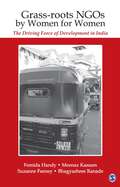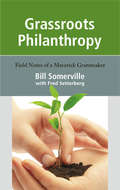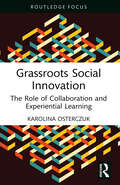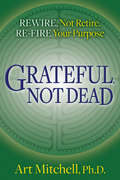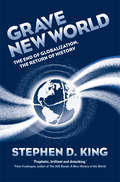- Table View
- List View
Graphic Design Business
by Entrepreneur MagazineIt's time to make your mark in the world of graphic design. There's no doubt you've imagined it-placing your name and logo on business cards, taking creative control and being your own boss. Why not turn your fantasy into reality?Whether you want to start a part-time graphic design business, a full-time operation or build a substantial company with a full staff of graphic designers, everything you need to get started is at your fingertips. Learn the basic requirements, startup costs, day-to-day operations and even what to do when things don't go as planned. Industry experts and successful graphic designers share what they've learned and give you the motivation and priceless tips and tricks to help you reach success. Learn how to:Discover your market and their needsChoose a business environment that works for youCreate a business brand that gets noticedWrite a marketing plan that captures clients and creates referralsDevelop profitable client relationshipsSet your feesBoost profits by expanding your specialty or your businessCombine your creativity with Entrepreneur's expert advice-and design your own successful graphic design business today!The First Three YearsIn addition to industry specific information, you'll also tap into Entrepreneur's more than 30 years of small business expertise via the 2nd section of the guide - Start Your Own Business. SYOB offers critical startup essentials and a current, comprehensive view of what it takes to survive the crucial first three years, giving your exactly what you need to survive and succeed. Plus, you'll get advice and insight from experts and practicing entrepreneurs, all offering common-sense approaches and solutions to a wide range of challenges. Pin point your target market Uncover creative financing for startup and growth Use online resources to streamline your business plan Learn the secrets of successful marketing Discover digital and social media tools and how to use them Take advantage of hundreds of resources Receive vital forms, worksheets and checklists From startup to retirement, millions of entrepreneurs and small business owners have trusted Entrepreneur to point them in the right direction. We'll teach you the secrets of the winners, and give you exactly what you need to lay the groundwork for success.BONUS: Entrepreneur's Startup Resource Kit!Every small business is unique. Therefore, it's essential to have tools that are customizable depending on your business's needs. That's why with Entrepreneur is also offering you access to our Startup Resource Kit. Get instant access to thousands of business letters, sales letters, sample documents and more - all at your fingertips!You'll find the following:The Small Business Legal ToolkitWhen your business dreams go from idea to reality, you're suddenly faced with laws and regulations governing nearly every move you make. Learn how to stay in compliance and protect your business from legal action. In this essential toolkit, you'll get answers to the "how do I get started?" questions every business owner faces along with a thorough understanding of the legal and tax requirements of your business.Sample Business Letters1000+ customizable business letters covering each type of written business communication you're likelyto encounter as you communicate with customers, suppliers, employees, and others. Plus a complete guide to business communication that covers every question you may have about developing your own business communication style.Sample Sales LettersThe experts at Entrepreneur have compliled more than 1000 of the most effective sales letters covering introductions, prospecting, setting up appointments, cover letters, proposal letters, the all-important follow-up letter and letters covering all aspects of sales operations to help you make the sale, generate new customers and huge profits.
Graphic Design Rants and Raves: Bon Mots on Persuasion, Entertainment, Education, Culture, and Practice
by Steven HellerDesign is everywhere. Graphic design enters into everything. This is the scope of designer Steven Heller's latest essay anthology that covers the spectrum of graphic design and related art and culture. Looking at design as practice, language, culture, and power, each of the forty-plus essays is a self-contained story. Heller pours out his ideas-criticisms and celebrations-on such topics as:A history of our modern Hindu-Arabic numerals, and a look at the letter KBrand design utilized by Hillary Clinton and Donald Trump early in the 2016 Presidential raceThe tumultuous relationship between design and sexThe Charlie Hebdo massacre and the principles of free expressionIcons revisited, including Paul Rand (not to be confused with the politician Rand Paul), Ralph Ginzburg, Frank Zachary, George Lois, and Print magazineFood packaging, the design of milk, and USPS stampsThe obsessive use of cuteness, and the sad and happy history of the ubiquitous happy face From commercial advertising to government institutions to cultural revolution, from the objects that push design forward to those that seep into the everyday, Graphic Design Rants and Raves is an exploration of how visual design has arrived in the twenty-first century.Allworth Press, an imprint of Skyhorse Publishing, publishes a broad range of books on the visual and performing arts, with emphasis on the business of art. Our titles cover subjects such as graphic design, theater, branding, fine art, photography, interior design, writing, acting, film, how to start careers, business and legal forms, business practices, and more. While we don't aspire to publish a New York Times bestseller or a national bestseller, we are deeply committed to quality books that help creative professionals succeed and thrive. We often publish in areas overlooked by other publishers and welcome the author whose expertise can help our audience of readers.
Graphic Design Solutions
by Robin LandaGRAPHIC DESIGN SOLUTIONS, 6th EDITION, is the most comprehensive reference on graphic design for print and screen media. It introduces the principles of design and how they apply to the various graphic design disciplines--all explained and illustrated with vivid, professional art and diagrams. Providing a solid foundation for typographic design, advertising design and graphic design, its in-depth coverage includes such topics as design principles, the design process, concept generation, branding and visual identity, design for web and mobile, package design, portfolio development, social media, ad campaigns and more. GRAPHIC DESIGN SOLUTIONS has everything you need to know to start formulating concepts and creating powerful, effective visual messages.
Graphic Design Theory: Readings from the Field
by Helen ArmstrongThis book presents ground-breaking, primary texts from the most important historical and contemporary design-thinkers.
Graphic Design for Architects: A Manual for Visual Communication
by Karen LewisGraphic Design for Architects is a handbook of techniques, explanations and examples of graphic design most relevant to architects. The book covers a variety of scales of graphic design, everything from portfolio design and competition boards, to signage and building super-graphics – to address every phase of architectural production. This book combines and expands on information typically found in graphic design, information design, and architectural graphics books. As architectural communication increases to include more territory and components of a project, it is important for designers to be knowledgeable about the various ways in which to communicate visually. For instance, signage should be designed as part of the process – not something added at the end of a project; and the portfolio is a manifestation of how the designer works, not just an application to sell a design sensibility. In thinking about architecture as a systematic and visual project, the graphic design techniques outlined in this book will help architects process, organize and structure their work through the lens of visual communication. Each chapter is titled and organized by common architectural modes of communication and production. The chapters speak to architects by directly addressing projects and topics relevant to their work, while the information inside each chapter presents graphic design methods to achieve the architects’ work. In this way, readers don’t have to search through graphic design books to figure out what’s relevant to them – this book provides a complete reference of graphic techniques and methods most useful to architects in getting their work done.
Graphic Idea Notebook: A Treasury of Solutions to Visual Problems
by Jan WhiteThis updated edition of the much-heralded classic of page design offers surefire ideas and inspiration to anyone stuck with the task of designing cutting-edge printed material. This book is a collection of more than 2,000 visual "idea generators"-illustrations and line art-that visualize the various abstract problems that page editors encounter. Previous editions of this book (0-8230-2149-1 and 0-9356-0364-6) have sold more than 57,000 copies "Jan White's are the very best working and how-to and why-to volumes available on the use of graphics in books and publications."--Publishers WeeklyAllworth Press, an imprint of Skyhorse Publishing, publishes a broad range of books on the visual and performing arts, with emphasis on the business of art. Our titles cover subjects such as graphic design, theater, branding, fine art, photography, interior design, writing, acting, film, how to start careers, business and legal forms, business practices, and more. While we don't aspire to publish a New York Times bestseller or a national bestseller, we are deeply committed to quality books that help creative professionals succeed and thrive. We often publish in areas overlooked by other publishers and welcome the author whose expertise can help our audience of readers.
Graphical Facilitation: Enabling Conversation And Learning Through Images
by Steve Hutchinson Curie ScottIf ‘a picture is worth a thousand words,’ this book provides an approach to help create professional pictures that productively and powerfully capture conversations and thinking for individual and collective learning. Individuals are bombarded by information, and organizations, managers, and teachers often lack a corresponding set of tools to make sense of this complexity—resulting in far too many “death by bullet-point” presentations. This is that toolkit, also offering invitations to readers to extend their thinking past these tools to enable the creation (and co-creation with teams, learners, and clients) of graphical depictions, models, and metaphors to help people make sense of their world. This accessible book is constructed as a visual reference so readers can quickly pick out the specific tool or strategy they need, whether working with individuals and teams to promote self-awareness, develop emotional intelligence, improve communication, or articulate vision and strategy.This clear and adaptable guide will be a welcome resource for teachers, trainers, managers, and coaches to empower people to learn, think, and create in a powerful, memorable, and graphical way.
Graphics Recognition. Current Trends and Evolutions: 12th IAPR International Workshop, GREC 2017, Kyoto, Japan, November 9-10, 2017, Revised Selected Papers (Lecture Notes in Computer Science #11009)
by Bart Lamiroy Alicia FornésThis book constitutes the thoroughly refereed post-conference proceedings of the 12th International Workshop on Graphics Recognition, GREC 2017, held in Kyoto, Japan, in November 2017. The 10 revised full papers presented were carefully reviewed and selected from 14 initial submissions. They contain both classical and emerging topics of graphics rcognition, namely analysis and detection of diagrams, search and classification, optical music recognition, interpretation of engineering drawings and maps.
Graphs and Combinatorial Optimization: CTW2020 Proceedings (AIRO Springer Series #5)
by Claudio Gentile Giuseppe Stecca Paolo VenturaThis book highlights new and original contributions on Graph Theory and Combinatorial Optimization both from the theoretical point of view and from applications in all fields. The book chapters describe models and methods based on graphs, structural properties, discrete optimization, network optimization, mixed-integer programming, heuristics, meta-heuristics, math-heuristics, and exact methods as well as applications. The book collects selected contributions from the CTW2020 international conference (18th Cologne-Twente Workshop on Graphs and Combinatorial Optimization), held online on September 14-16, 2020. The conference was organized by IASI-CNR with the contribution of University of Roma Tre, University Roma Tor Vergata, and CNRS-LIX and with the support of AIRO. It is addressed to researchers, PhD students, and practitioners in the fields of Graph Theory, Discrete Mathematics, Combinatorial Optimization, and Operations Research.
Grapple and Grow: Reinforcing the Cycle of Excellence-Encouraging Peak Performance by Making Work Challenging and Fun
by Edward M. HallowellWhen work doesn't lead to growth and positive results, it's often due to the chaos of modern life-the constant distractions and interruptions of the typical workplace and the pressure to do more (faster!) with fewer resources. In this chapter, bestselling author ("Driven to Distraction") and practicing psychiatrist Edward Hallowell focuses on "Grapple and Grow"-the combination of work and progress-as the fourth step in the Cycle of Excellence. This step is where you want your people to spend most of their time-working. But if you don't handle it right, work becomes drudgery and productivity sags. To succeed, you must tend to the first three steps of the cycle: Select what to focus on, create a positively connected atmosphere, and encourage imaginative engagement. Once you've done that, you'll notice that your people want to work harder and that work is what it ought to be-fun. Using real-life examples and new discoveries in the field of brain science, Hallowell also explains how you, as a manager, can minimize "toxic stress" and promote "positive stress" in the form of surmountable, growth-sustaining challenges your employees will want to embrace. The chapter concludes with a list of ten steps you can take to help your employees grapple with the demands of their jobs and achieve peak performance-every day. This chapter was originally published as Chapter 5 of "Shine: Using Brain Science to Get the Best from Your People."
Grasp: The Science Transforming How We Learn
by Sanjay Sarma Luke YoquintoA groundbreaking look at the science of learning—how it's transforming education and how we can use it to discover our true potential, as individuals and across society by a renowned MIT professorAs the head of Open Learning at MIT, Sanjay Sarma has a daunting job description: to fling open the doors of the MIT experience for the benefit of the wider world. But if you're going to undertake such an ambitious project, it behooves you to ask: How exactly does learning work? What conditions are most conducive? Are our traditional classroom methods—lecture, homework, test, repeat—actually effective? And if not, which techniques are? Grasp takes readers across multiple frontiers, from fundamental neuroscience to cognitive psychology and beyond, as it explores the future of learning. Some of its findings: • Scientists are studying the role of forgetting, exposing it not as a simple failure of memory but a critical weapon in our learning arsenal. • New developments in neuroimaging are helping us understand how reading works in the brain. It's become possible to identify children who might benefit from specialized dyslexia interventions—before they learn to read.• Many schools have begun converting to flipped classrooms, in which you watch a lesson at home, then do your 'homework' in class. Through such bold instructional changes, MIT has eliminated the gender performance gap in its introductory physics courses.• By structuring its curriculum to better incorporate cutting-edge learning strategies, one law school in Florida has rocketed to the top of its state in bar exam passage rates. Along the way, Sarma debunks long-held views (such as the noxious idea of "learning styles"), while equipping readers with a set of practical tools for absorbing and retaining information across a lifetime. He presents a vision for learning that's more inclusive and democratic—revealing a world bursting with powerful learners, just waiting for the chance they deserve. Drawing from the author's experience as an educator and the work of researchers and educational innovators at MIT and beyond, Grasp offers scientific and practical insight, promising not just to inform and entertain readers but to open their minds.
Grass Productivity: An Introduction To Rational Grazing (Conservation Classics Ser.)
by Allan Savory Philosophical Library Pub. Andre VoisinGrass Productivity is a prodigiously documented textbook of scientific information concerning every aspect of management "where the cow and grass meet." Andre Voisin's "rational grazing" method maximizes productivity in both grass and cattle operations.
Grass Roots Leaders: The BrainSmart Revolution in Business
by Tony Buzan Tony DottinoGrass Roots Leaders galvanizes the emotional enthusiasm of the workforce and taps the wealth of their brain power to create an engine of innovation that ripples through the organization from the bottom up and powers it forward. Tony Buzan, Tony Dottino and Richard Israel pick up a theme they first introduced nearly a decade ago in The Brain Smart Leader and document a way of fundamentally changing the perspective and behaviour of leaders and employees in your organization. Their approach shows how to: * use the brain's capacity for solving problems and implementing innovative plans to make the organization's vision a reality; * adopt a three-speed technique - first gear to slow down and allow new learning or support for difficult transition periods. Second gear shifts up to a productive work outcome, and then third gear revs up to champion innovation and change; * apply a series of proven models for dealing with information overload, making the best use of scarce resources, such as time, and keeping sight of successful outcomes as they are developed. The book accurately captures the current state of thinking in organizations, as well as the latest research on how our brains work, to deliver a radical blueprint for how organizations need to change to survive and what this means to their managers and to their employees. If you are a leader who longs to use the grass roots intellectual capital in your organization but, given the quantity of meetings, e-mail, crises and reorganizations, you simply haven't had the time, this book is for you. And if you are an employee who is sick and tired of daily stress, bad planning and poorly thought-through changes and implementations, customer complaints but no improvements, this book is for you, too. A Brain Smart Revolution in Business starts with one person. You.
Grass-Fed Cattle: How to Produce and Market Natural Beef
by Julius RuechelSuccessfully raise grass-fed cattle and enjoy the benefits of great-tasting beef and a financially stable enterprise. In this comprehensive guide, Julius Ruechel covers every aspect of raising healthy and thriving grass-fed cattle, offering advice on herd selection, pasture management, medical care, necessary equipment, winter grazing, slaughtering procedures, and more. With tips on creating a viable business plan and identifying niche markets for your beef, Ruechel provides everything you need to know to develop a profitable and environmentally sustainable grass-fed cattle operation.
Grassroots Environmental Governance: Community engagements with industry (Routledge Research in Global Environmental Governance)
by Michael J. Watts Leah S. HorowitzGrassroots movements can pose serious challenges to both governments and corporations. However, grassroots actors possess a variety of motivations, and their visions of development may evolve in complex ways. Meanwhile, their relative powerlessness obliges them to forge an array of shifting alliances and to devise a range of adaptive strategies. Grassroots Environmental Governance presents a compilation of in-depth ethnographic case studies, based on original research. Each of the chapters focuses specifically on grassroots engagements with the agents of various forms of industrial development. The book is geographically diverse, including analyses of groups based in both the global North and South, and represents a range of disciplinary perspectives. This allows the collection to explore themes that cross-cut specific localities and disciplinary boundaries, and thus to generate important theoretical insights into the complexities of grassroots engagements with industry. This volume will be of great interest to scholars of environmental activism, environmental governance, and environmental studies in general.
Grassroots Innovation Movements (Pathways to Sustainability)
by Adrian Smith Mariano Fressoli Dinesh Abrol Elisa Arond Adrian ElyInnovation is increasingly invoked by policy elites and business leaders as vital for tackling global challenges like sustainable development. Often overlooked, however, is the fact that networks of community groups, activists, and researchers have been innovating grassroots solutions for social justice and environmental sustainability for decades. Unencumbered by disciplinary boundaries, policy silos, or institutional logics, these ‘grassroots innovation movements’ identify issues and questions neglected by formal science, technology and innovation organizations. Grassroots solutions arise in unconventional settings through unusual combinations of people, ideas and tools. This book examines six diverse grassroots innovation movements in India, South America and Europe, situating them in their particular dynamic historical contexts. Analysis explains why each movement frames innovation and development differently, resulting in a variety of strategies. The book explores the spaces where each of these movements have grown, or attempted to do so. It critically examines the pathways they have developed for grassroots innovation and the challenges and limitations confronting their approaches. With mounting pressure for social justice in an increasingly unequal world, policy makers are exploring how to foster more inclusive innovation. In this context grassroots experiences take on added significance. This book provides timely and relevant ideas, analysis and recommendations for activists, policy-makers, students and scholars interested in encounters between innovation, development and social movements.
Grassroots Innovation: Discourse, Policy and Practice in the Global South (Routledge Studies in Innovation, Organizations and Technology)
by Gautam Sharma Hemant KumarThis book explores the process of grassroots innovation in the context of the Global South. It explains why these bottom-up solutions developed by common people are generated due to a lack of available or affordable technology to meet their needs and how they are included in the mainstream imagination of the economy by studying these innovations in India. It analyses the grassroots innovation process from idea generation to its implementation.Detailing both theoretical and practical dimensions of grassroots innovation, the book provides a holistic understanding of the phenomenon by tracing its history in the pre-independence discourse on development to the present-day policies for institutionalizing these innovations in the mainstream. It will provide the readers with a bottom-up commentary on innovation and development in the context of the Global South in general and India in particular. It adopts a qualitative research design with a wide range of data collected through interviews, participant observations, and field notes. The book contains seven chapters to describe the discourse, policy perspectives, and current practice of grassroots innovations in general.The interdisciplinary, timely book provides thoughtful analysis for scholars and upper-level students in the fields of technology and innovation management, development studies, and public management.
Grassroots Leviathan: Agricultural Reform and the Rural North in the Slaveholding Republic (Studies in Early American Economy and Society from the Library Company of Philadelphia)
by Ariel RonHow the vast agricultural reform movement undertaken by northern farmers before the Civil War fundamentally recast the relationship of rural Americans to market forces and governing structures.Recipient of The Center for Civil War Research's 2021 Wiley-Silver Book Prize, Winner of the Theodore Saloutos Memorial Award by the Agricultural History SocietyThe United States was an overwhelmingly rural society before the Civil War and for some time afterward. There were cities and factories, of course, especially in the northern seaboard states. In 1860, Manhattan's population was nearing a million. Brooklyn, which had been farmland at the time of the American Revolution, was itself home to 250,000. New England's mill towns were already well known, and Chicago's growth elicited awe. But these were exceptions. In the same year, 80% of Americans lived in rural places of 2,500 inhabitants or fewer. While 59% of the labor force worked in agriculture, only 15% worked in manufacturing. As the newspaperman Jesse Buel put it at the time, agriculture remained "the great business of civilized life." In this sweeping look at rural society from the American Revolution to the Civil War, Ariel Ron argues that agricultural history is absolutely central to understanding the nation's formative period. Upending the myth that the Civil War pitted an industrial North against an agrarian South, Grassroots Leviathan traces the rise of a powerful agricultural reform movement spurred by northern farmers. Showing that farming dominated the lives of the majority of Americans, in the North and the South, through almost the entire nineteenth century, Ron traces how middle-class farmers in the "Greater Northeast" built a movement of semipublic agricultural societies, fairs, and periodicals that, together, fundamentally recast the relationship of rural people to market forces and governing structures. By the 1850s, Ron writes, this massive movement boasted over a thousand organizations and the influence to have Congress publish annual agricultural reports in editions that rivaled sales of Uncle Tom's Cabin, the era's runaway bestseller. As northern farmers became increasingly organized, they pressed new demands on the federal government that inevitably challenged the entrenched prerogatives of southern slaveholders. Ideologically and organizationally, agricultural reform conditioned the emergence of the Republican Party and the North's break with the slaveholding republic. The movement culminated in the creation of the US Department of Agriculture and the land-grant university system. These agencies reconfigured the nature and purpose of the American state at the same time as they came to revolutionize farming in the United States and the world over.Looking at farmers as serious independent agents in the making, unmaking, and remaking of the American republic, Grassroots Leviathan offers an original take on the causes of the Civil War, the rise of federal power, and American economic ascent during the nineteenth century.
Grassroots NGOs by Women for Women: The Driving Force of Development in India
by Femida Handy Suzanne Feeney Meenaz Kassam Bhagyashree RanadeAdopting an inter-disciplinary approach, this book provides an in-depth understanding of why Indian NGOs run by women for women, tend to be successful. Based on first-hand observations spanning five years and interviews with 20 founders of NGOs, this book explores the factors that motivate and facilitate women entrepreneurship in the development sector. It examines the organizational structures that have evolved based on feminist ideology and the services provided (e.g. self-help groups and micro-finance). The authors also discuss the social impact of these NGOs in promoting both development and women’s empowerment. They show how small NGOs are particularly effective in garnering support from the grass-roots and in tapping the knowledge base of local communities. Overall, the authors find that women entrepreneurs act as facilitators with a unique leadership style and that they encourage community-based movements grounded in local issues. As a result, these NGOs are successfully changing the landscape of rural poverty in India while ushering in sustainable development.
Grassroots Philanthropy: Field Notes of a Maverick Grantmaker
by Fred Setterberg Bill SomervilleSet aside the mountains of paper that characterize conventional philanthropy and focus instead on forging enduring partnerships with outstanding individuals. Dare to change the world in imaginative ways that prove deeply satisfying, exciting, and (dare we say it?) fun. Based on four decades of experience as a foundation executive, Bill Somerville's Grassroots Philanthropy is an unorthodox guide to decisive, hands-on grantmaking. Straightforward, persuasive, and exhilarating, Somerville's courageous and thoughtful approach to grantmaking will energize and motivate foundation and nonprofit leaders alike.
Grassroots Social Innovation: The Role of Collaboration and Experiential Learning (Routledge Focus on Business and Management)
by Karolina OsterczukThis book examines the transformative power of grassroots social innovations within dynamic urban landscapes. From addressing access to healthy food to navigating regulatory challenges, urban citizens are taking charge of their environments through collective action. This ethnographic exploration explores the everyday workings of three grassroots initiatives, highlighting the practices driving social change.Readers will discover practical models for collective organizing within social innovation communities, offering insights for both activists and policymakers eager to effect change in urban life. By emphasizing collaboration as a cornerstone of social innovation, this book illuminates how deep engagement fosters reflectivity, empathy, and sustainability within communities. Drawing on multidimensional collaboration models, readers gain practical tools for creating lasting social impact.Moreover, the book places these insights within a broader European context and references Elinor Ostrom's theory of the common good, appealing to readers worldwide interested in community-driven solutions. With qualitative research conducted in Poland, this book offers a rich tapestry of insights into the global phenomenon of grassroots social innovation, encouraging reflection and action among urban communities worldwide.
Grassroots for Hire
by Edward T. WalkerAlthough 'grassroots' conjures up images of independent citizen organizing, much mass participation today is sponsored by elite consultants working for corporations and powerful interest groups. This book pulls back the curtain to reveal a lucrative industry of consulting firms that incentivize public activism as a marketable service. Edward Walker illustrates how, spurred by the post-sixties advocacy explosion and rising business political engagement, elite consultants have deployed new technologies to commercialize mass participation. Using evidence from interviews, surveys and public records, Grassroots for Hire paints a detailed portrait of these consultants and their clients. Today, Fortune 500 firms hire them to counter-mobilize against regulation, protest or controversy. Ironically, some advocacy groups now outsource organizing to them. Walker also finds that consultants are reshaping both participation and policymaking, but unethical 'astroturf' strategies are often ineffective. This pathbreaking book calls for a rethinking of interactions between corporations, advocacy groups, and elites in politics.
Grateful, Not Dead: Rewire, Not Retire. Re-fire Your Purpose
by Art MitchellA guide to uncovering your post-retirement purpose and creating financial security.Art Mitchell uses the REWIREMENT process to empower and transform himself and people like you. He details ten critical steps to inform aging, building on the anti-ageism and conscious aging movements.In Grateful, Not Dead, you learn how to:overcome ageist myths and shame to change everything for yourselfreboot your mind through self-reflection, consciousness expansion, and spiritualityuncover purpose, boost creativity, increase engagement, and servicefind meaningful work and achieve financial independencetake back your power and make the changes you want to seeThose of you who have been forced to make career changes, retire, or otherwise chose to work past “retirement age” may find yourself wanting help. It’s here. Prepare to learn how to live purposefully and inspired to do what’s important to you!“Grateful, Not Dead is the best I have read to assist you in resetting your life script for the happiest, youthful aging!” —C. Norman Shealy, MD, PhD(from Foreword)“After decades in careers that have defined us, what's the next step? Guided by the author's life wisdom and skills as a coach, readers find their own answers through inspiration and exercises that tap into personal power and purpose.” —Lois Guarino, author of Writing Your Authentic Self“Art Mitchell has written an indispensable guidebook for people entering the territory of older age.” —Harry R. Moody, retired Vice President, AARP
Grave New World: The End of Globalization, the Return of History
by Stephen D. KingA controversial look at the end of globalization and what it means for prosperity, peace, and the global economic order Globalization, long considered the best route to economic prosperity, is not inevitable. An approach built on the principles of free trade and, since the 1980s, open capital markets, is beginning to fracture. With disappointing growth rates across the Western world, nations are no longer willing to sacrifice national interests for global growth; nor are their leaders able—or willing—to sell the idea of pursuing a global agenda of prosperity to their citizens. Combining historical analysis with current affairs, economist Stephen D. King provides a provocative and engaging account of why globalization is being rejected, what a world ruled by rival states with conflicting aims might look like, and how the pursuit of nationalist agendas could result in a race to the bottom. King argues that a rejection of globalization and a return to “autarky” will risk economic and political conflict, and he uses lessons from history to gauge how best to avoid the worst possible outcomes.
Grave New World: The End of Globalization, the Return of History
by Stephen D. KingA controversial look at the end of globalization and what it means for prosperity, peace, and the global economic order Globalization, long considered the best route to economic prosperity, is not inevitable. An approach built on the principles of free trade and, since the 1980s, open capital markets, is beginning to fracture. With disappointing growth rates across the Western world, nations are no longer willing to sacrifice national interests for global growth; nor are their leaders able—or willing—to sell the idea of pursuing a global agenda of prosperity to their citizens. Combining historical analysis with current affairs, economist Stephen D. King provides a provocative and engaging account of why globalization is being rejected, what a world ruled by rival states with conflicting aims might look like, and how the pursuit of nationalist agendas could result in a race to the bottom. King argues that a rejection of globalization and a return to “autarky” will risk economic and political conflict, and he uses lessons from history to gauge how best to avoid the worst possible outcomes.

